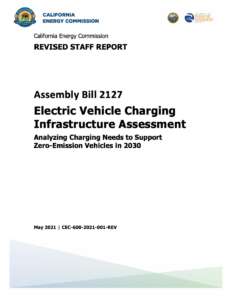Full Title: Electric Vehicle Charging Infrastructure Assessment: Analyzing Charging Needs to Support Zero-Emission Vehicles in 2030
Author(s): Matt Alexander, Noel Crisostomo, Wendell Krell, Jeffrey Lu, Raja Ramesh
Publisher(s): California Energy Commission
Publication Date: May 28, 2021
Full Text: Download Resource
Description (excerpt):
This inaugural Assembly Bill (AB) 2127 Electric Vehicle Charging Infrastructure Assessment examines charging needs to support California’s plug-in electric vehicles (PEVs) in 2030. Under AB 2127, the California Energy Commission (CEC) is required to publish a biennial report on the charging needs of 5 million zero emission vehicles (ZEVs) by 2030. In September 2020, Governor Gavin Newsom issued Executive Order N-79-20, which directed the Commission to update this assessment to support expanded ZEV adoption targets.
In 2018, Executive Order B-48-18 set a goal of having 250,000 chargers (including 10,000 direct current fast chargers) by 2025. As of January 4, 2021, California has installed more than 70,000 public and shared chargers, including nearly 6,000 direct current fast chargers. This report finds that an additional 123,000 are planned, of which about 13,600 are fast chargers, which leaves a gap of about 57,000 installations, including 430 fast chargers, from the 250,000 chargers goal.
For passenger vehicle charging in 2030, this report projects over 700,000 public and shared private chargers are needed to support 5 million ZEVs, and nearly 1.2 million to support about 8 million ZEVs anticipated under Executive Order N-79-20. An additional 157,000 chargers are needed to support 180,000 medium- and heavy-duty vehicles anticipated for 2030.
A portfolio of charging solutions is needed to address site-specific real estate and grid constraints. To maximize grid integration, energy resilience, and ease of use, charging equipment hardware and software should use common connector and communication standards.
